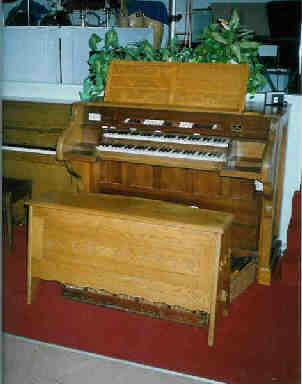Broadway United Presbyterian Church
Bellingham, WA
Opus 978

Great
8' Gr. Open
Diapason
61
8' Gr. Melodia 61
8' Gr. Dulciana (tc) 49
8' Gr. Melodia 61
8' Gr. Dulciana (tc) 49
4' Gr.
Octave
61
Swell
(Enclosed)
8' Sw. Stopped Diapason 61
8' Sw. Stopped Diapason 61
8' Sw.
Salicional
61
8' Sw. Voix
Celeste
(tc) 49
4' Sw. Flute
Harmonic
61
8' Sw. Oboe [labial] (tc) 49
8' Sw. Oboe [labial] (tc) 49
Sw.
Tremolo
Pedal
16' Ped.
Bourdon
30
16' Ped. Lieblich
Gedeckt (Sw) - -
Couplers
Undocumented
Foot Levers
Undocumented
Undocumented
Pedal
Movements
Swell
Expression
balanced
Action: Tubular-Pneumatic key & stop
Voices:
10
Stops:
10
Ranks:
10
Pipes: 543
Pipes: 543
Notes
The organ was originally free-standing and encased. And the
facade contained gold-painted pipes.
We know from the extant organ that the first 15 pipes of the Great 8' Open Diapason were in the facade.
The keydesk was originally attached and projecting with a Haskell-style stop action. The exact nomenclature of stops
and controls can not be verified since the organ has been electrified. Names given are based on the extant pipes and chests,
and on other extant and documented examples of the builder's work from this period. The Great 8' Dulciana borrows
its bottom octave from the stopped bass of the 8' Melodia. Similarly, the Swell 8' Salicional borrows it bottom octave
from the bass of the 8' Stopped Diapason.
We know from the extant organ that the first 15 pipes of the Great 8' Open Diapason were in the facade.
The keydesk was originally attached and projecting with a Haskell-style stop action. The exact nomenclature of stops
and controls can not be verified since the organ has been electrified. Names given are based on the extant pipes and chests,
and on other extant and documented examples of the builder's work from this period. The Great 8' Dulciana borrows
its bottom octave from the stopped bass of the 8' Melodia. Similarly, the Swell 8' Salicional borrows it bottom octave
from the bass of the 8' Stopped Diapason.
In 1949, Balcom and Vaughan was contracted to electrify and
modernize the organ as their opus 464. It was placed in a single
chamber under expression and a used set of Kimball shutters was
refurbished and installed. The original tubular-pneumatic action was
changed to electro-pneumatic. The keydesk was removed from the case and
filled-out to create an independent, detached console. And a new
stop rail replaced the original Haskell stop action. A 21-note
set of chimes were added.
No tonal changes were made and the original chests were retained.
No tonal changes were made and the original chests were retained.
The church changed its name to First United Presbyterian
before the 1949 electrification. In 19__, the Presbyterians sold their
building to another congregation and the church was renamed Broadway
Christian Church. By the early 1990's, that congregation had
dwindled to the point that only about a dozen members were attending
worship, and services were held in one of the smaller classrooms rather
than the sanctuary. In 1991, the Christian congregation sold the
building to Abundant Life Pentecostal Church. That congregation
installed a dropped ceiling in the sanctuary, placing the organ chamber
above the ceiling.
The organ was not used by the fundamentalist group. In 1993, they made it available for purchase.
The organ was not used by the fundamentalist group. In 1993, they made it available for purchase.
It was purchased in 1995 by Mr. Don Stagg of Blaine, WA., and
was installed in his home with the help of friends.
Mr. Stagg is a skilled musician, playing piano, harpsicord, and organ. He has been a regular performer at Bellingham's
Mt. Baker Theatre. And he played at New York's Carnegie Hall. He also has in his home a I-manual, ca. 1863 Wm. A. Johnson tracker; a one-of-a-kind Sabathil & Son double harpsichord; a Sabathil & Son clavichord; a second clavichord made by Dominic Parker; a large Packard reed organ, several melodeons, An Everett 'Orgatron'; a Hammond, and about a dozen grand pianos by Steinway, Collard & Collard, Hardmann, a square grand with corrugated soundboard, and others.
The Estey is installed in a basement chamber and speaks into the living room through a floor grate, with the
console in the living room. The organ is maintained by James Stettner, and is used regularly for entertaining guests
and school children from the Bellingham and local Blaine school districts.
Mr. Stagg is a skilled musician, playing piano, harpsicord, and organ. He has been a regular performer at Bellingham's
Mt. Baker Theatre. And he played at New York's Carnegie Hall. He also has in his home a I-manual, ca. 1863 Wm. A. Johnson tracker; a one-of-a-kind Sabathil & Son double harpsichord; a Sabathil & Son clavichord; a second clavichord made by Dominic Parker; a large Packard reed organ, several melodeons, An Everett 'Orgatron'; a Hammond, and about a dozen grand pianos by Steinway, Collard & Collard, Hardmann, a square grand with corrugated soundboard, and others.
The Estey is installed in a basement chamber and speaks into the living room through a floor grate, with the
console in the living room. The organ is maintained by James Stettner, and is used regularly for entertaining guests
and school children from the Bellingham and local Blaine school districts.
Sources
Estey opus list
Balcom and Vaughan opus list & files
Extant, electrified organ
Balcom and Vaughan opus list & files
Extant, electrified organ
James R. Stettner
Back
